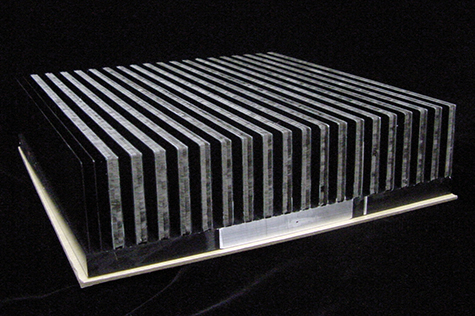Conducting the Heat
Heat conduction plays an important role in the efficiency and life span of electronic components. To keep electronic components running efficiently and at a proper temperature, thermal management systems transfer heat generated from the components to thermal surfaces such as heat sinks, heat pipes, radiators, or heat spreaders. Thermal surfaces absorb the heat from the electrical components and dissipate it into the environment, preventing overheating.
To ensure the best contact between electrical components and thermal surfaces, thermal interface materials are applied. In addition to having high conductivity, ideal thermal interface materials should be compliant to conform to the components, increasing the surface contact. While many different types of interface materials exist for varying purposes, Energy Science Laboratories, Inc. (ESLI), of San Diego, California, proposed using carbon velvets as thermal interface materials for general aerospace and electronics applications.
NASA's Johnson Space Center granted ESLI a Small Business Innovation Research (SBIR) contract to develop thermal interface materials that are lightweight and compliant, and demonstrate high thermal conductance even for nonflat surfaces. Through Phase II SBIR work, ESLI created Vel-Therm® for the commercial market. Vel-Therm is a soft, carbon fiber velvet consisting of numerous high thermal conductivity carbon fibers anchored in a thin layer of adhesive. The velvets are fabricated by precision cutting continuous carbon fiber tows and electrostatically "flocking" the fibers into uncured adhesive, using proprietary techniques.
Johnson granted ESLI a Phase III SBIR contract to evaluate its thermal interface material for applications on the International Space Station (ISS). Avionics and batteries mounted externally on the ISS must be easily replaceable by astronauts or robotics. To serve ISS needs, the components are packaged as orbital replaceable units (ORUs). These ORUs require thermal contact with the ISS thermal control system to keep the component temperatures within required limits. The current design of the ORU thermal interface consists of interleaving black-anodized aluminum fins which radiatively exchange heat. Adding ESLI Vel-Therm to the fins of the ORU improves thermal contact by replacing radiative with conductive heat exchange. The removable ORU fins slide into place over the fins of the mating heat sink mounted on the ISS.
Vel-Therm has commercial applications in the aerospace and electronics industries. It particularly benefits applications with large or uneven gaps or sliding interfaces. Each fiber provides a thermal path from the electronic component to the thermal surface. In addition to having high conductivity, the material makes intimate contact with interfacing surfaces because of its high compliance. Each fiber bends independently, allowing the fibers to come into contact with both surfaces, even when the surfaces are not parallel, flat, or smooth. A minimal amount of pressure is required for intimate contact, precluding the need for heavy bolts or clamping mechanisms, and eliminating the necessity of flat, smooth mating surfaces.
Vel-Therm® is a registered trademark of Energy Science Laboratories, Inc.

This finned interface prototype of an orbital replaceable unit for the International Space Station has Vel-Therm® applied to every other fin slot.













